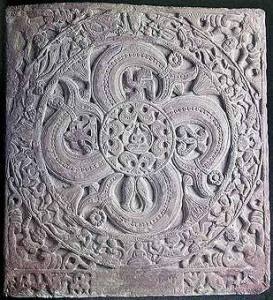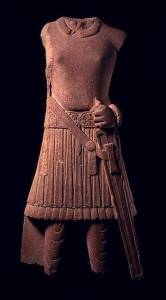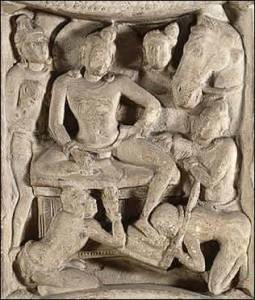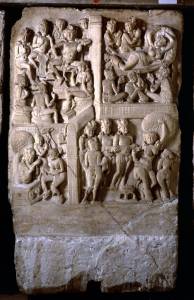Areas of Interest – North, South & East India (specifically Kalinga)
The five centuries that passed between the fall of the Mauryas and rise of the Guptas witnessed a lot of political instability and upheaval in the North of India. The South however remained fairly stable.
NORTH INDIA
I. Political Background
As the maps suggest, many kingdoms came up in North India. Despite being foreign rulers, they were assimilated in our culture and influenced it in many ways. The 3 most important among them were
1. Sunga Empire (185BCE–73 BCE) – East India
They succeeded the Mauryan Empire in Magadha. Pushyamitra Sunga was the first king of this dynasty.
2. Indo-Greek Kingdom (180BCE – 010AD) – North West India
The Greeks were the first foreign power in the sub-continent. After Alexander left, his generals stayed back. Hence the term Indo-Greek. They brought the Greek culture. Menander(165-145 BC) was the most important king in this time. In Pali Literature he is known as Milinda.
3. Indo-Scythian or Sakas (200 BC–400 AD) – West India
Sakas or Scythians where nomadic Central Asian tribes who destroyed the Indo-Greek rule in north-western India. They were pushed out from Central Asia and came to India. The Sakas were divided in five branches. Around 100AD, they give rise to Kushana Empire and Western Kshatrapas.
| SL No. | Early | Later (100AD) |
| 1 | Afghanistan | Kushanas
(60AD–240 AD) |
| 2 | Punjab (Taxila) | |
| 3 | Mathura | |
| 4 | Maharashtra + Saurashtra | Western Kshatrapa (27 independent)
(35AD–405AD) |
| 5 | Central India (Ujjain) |
Kanishka is the most celebrated king of Kushana empire. At its peak, his empire extended from Khotan in the northwest to Benaras in the east and Kashmir in north to Saurashtra and Malwa in the south. The capital of his empire was Purushapur i.e. modern Peshawar.
II. Literature
Many important works of literature happened in this era.
| Work | Author | Theme | Patronage |
| Junagarh Rock inscription | Rudradaman I
from the Western Kshatrapa |
He’s credited to have issued the 1st long inscription in chaste Sanskrit.
It mentions the repairs he undertook to improve the Sudershana Lake. Junagarh Rock also contains inscriptions from Ashoka and Skandgupta (from the Gupta Period almost 800 years later). |
Rudradaman I |
| Milindapanho | Nagasena | Menander asked Nagasena many questions related to philosophy and Buddhism, which together with Nagasena’s answers are recorded in Milindapanho or the Questions of Milinda. | Milinda |
| Saundarananda, Buddhacharita,
Vajrasuchi |
Ashvaghosh | Buddhacharita is a complete lifecof Buddha written in the form of Mahakavya. It is the first Buddist book written in Sanskrit. | Kanishka |
| Charaka-Samhita | Charaka | Extends Ayurveda and lays down the concept of balance of 3 doshas called Vata, Pitta and Kapha. | |
| Sushruta-Samhita | Sushruta(Father of Surgery) | He mentions more than 120 instruments |
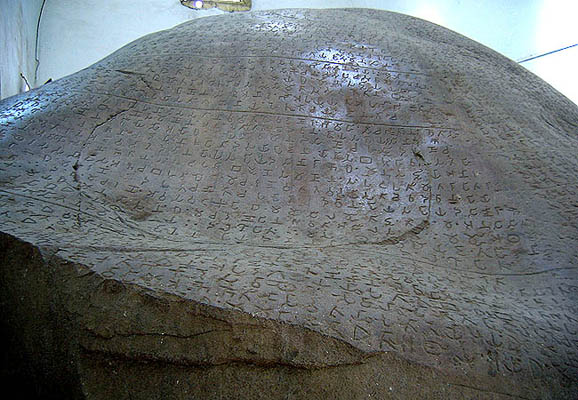
Junagarh Rock inscription.
III. Religion
1. Hinduism
Vaishnavism – There were 3 streams centered around worship of Vishnu or Bhagawat
- Vishnu as a minor god in Vedic times. Was worshipped as the Sun and fertility cult.
- Narayana was a non-vedic tribal god. He was also called bhagavat.
- Vishnu came to be identified as the hero of the vrishni tribe known as Krishna-Vasudeva.
By 200BC all these 3 streams merged into one and led to the creation of Bhagvatism. By the end of late Gupta Period, it’s assimilated into Vaishnavism and was commonly referred by the latter.
2. Buddhism
Buddhism continued to receive royal patronage. Many kings of this era were Buddhists. Kanishka’s court was adorned by the presence of such scholars as Parsva, Vasumitra, Ashvaghosha, Charaka, and Nagarjuna.
A major development in Buddhism was it’s splitting up in to two sects –The Hinayana and the Mahayana. Kanishka organized the 4th Buddhist council where this split happened.
| Hinayana | Mahayana |
| Also known as Lesser Vehicle | Greater Vehicle |
| Treat Buddha has a guide (Since Buddha never said he was God) | Treat Buddha as a God |
| Worshipped only in form of symbols that represent various stages in the life of Buddha | Worshipped in human form, Bodhisattvas. |
| Literature only in Pali | Sanskrit |
This phase also witnessed the spreading of Mahayana Buddhism to south and south east Asia.
IV. Architecture
1. Stupas
The Sungas were great patrons of art and architecture. They contributed to the expansion of Bharut and Sanchi Stupas.
Bharhut and Sanchi
| Bharut | Sanchi | |
| Time Period | 100 BC is the accepted date for Bharut. Slightly earlier than Sanchi and Ajanta.
Said to have been started by Ashoka but much of its work has been done in the time of the Sungas. |
100 BC.
Said to have been started by Ashoka but much of its work has been done in the time of the Sungas. The decorated gateways with lavish carvings were done by Satavahanas. |
| Location | Satna District of MP. Was on a major trade route from western coastal regions to Pataliputra.
|
A very large complex 13-14km from Vidisha, the capital of Mauryan Empire. Vidisha was a very important trading town. It was on the Dakshinapath – an offshoot of the Uttarapath, which connected Taxila to Pataliputra and further east. |
| Stupa | Has been reconstructed in Indian Museum Calcutta | There are 3 stupas
Stupa 1- The Great Stupa. Largest of them. It has 4 gates with Toranas. Stupa 2 – This is the earliest stupa. Same time as Bharut but simpler. Stupa 3 –Has only 1 Torana. |
Bharut : Themes Represented
Discovered by Cunninghum. Has been reconstructed in Indian Museum Calcutta. Stone Architecture. Surrounded by Vedika roughly 3 feet.
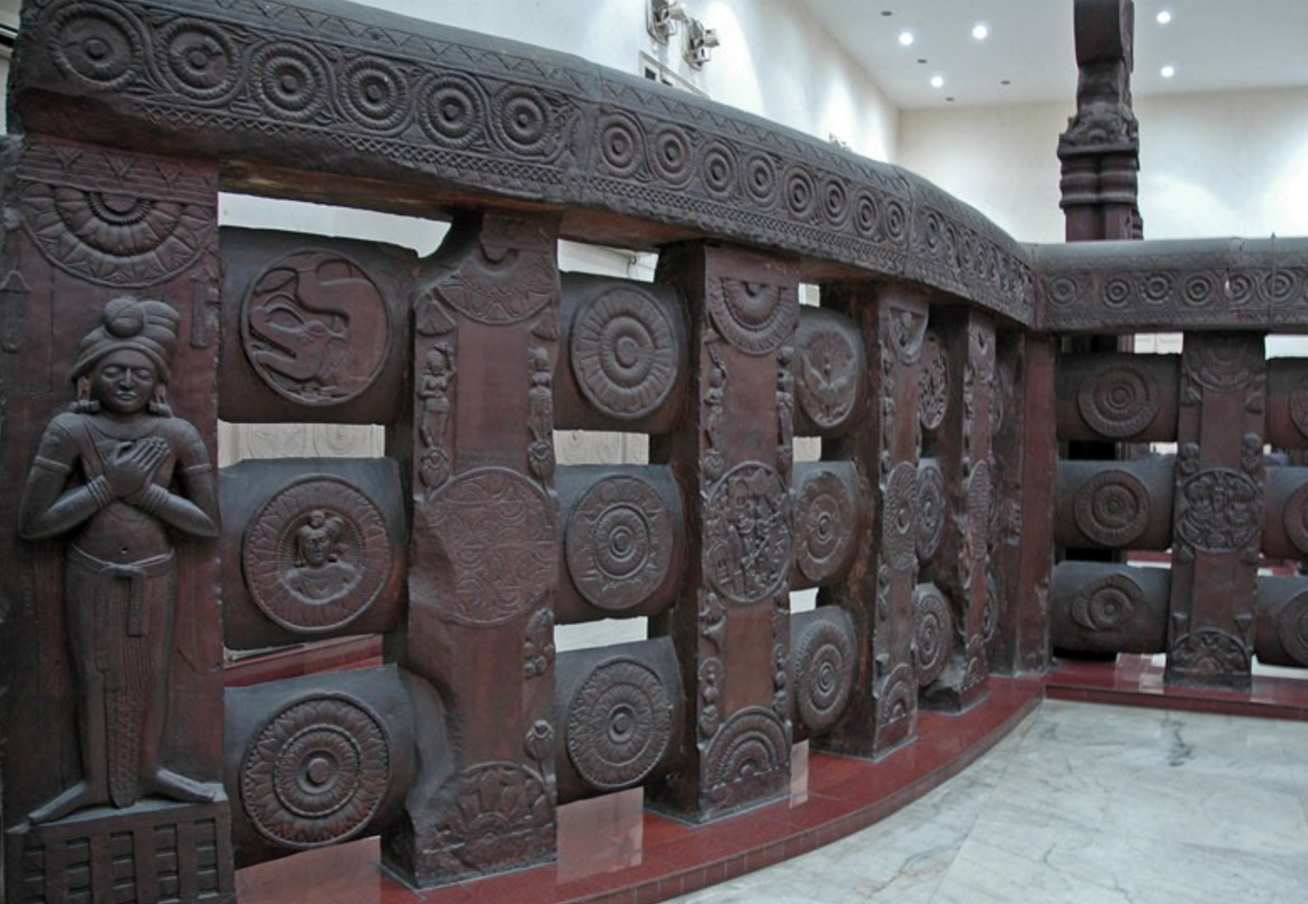
Only 1 Torana has been found but it is suspected that there would’ve been 4.
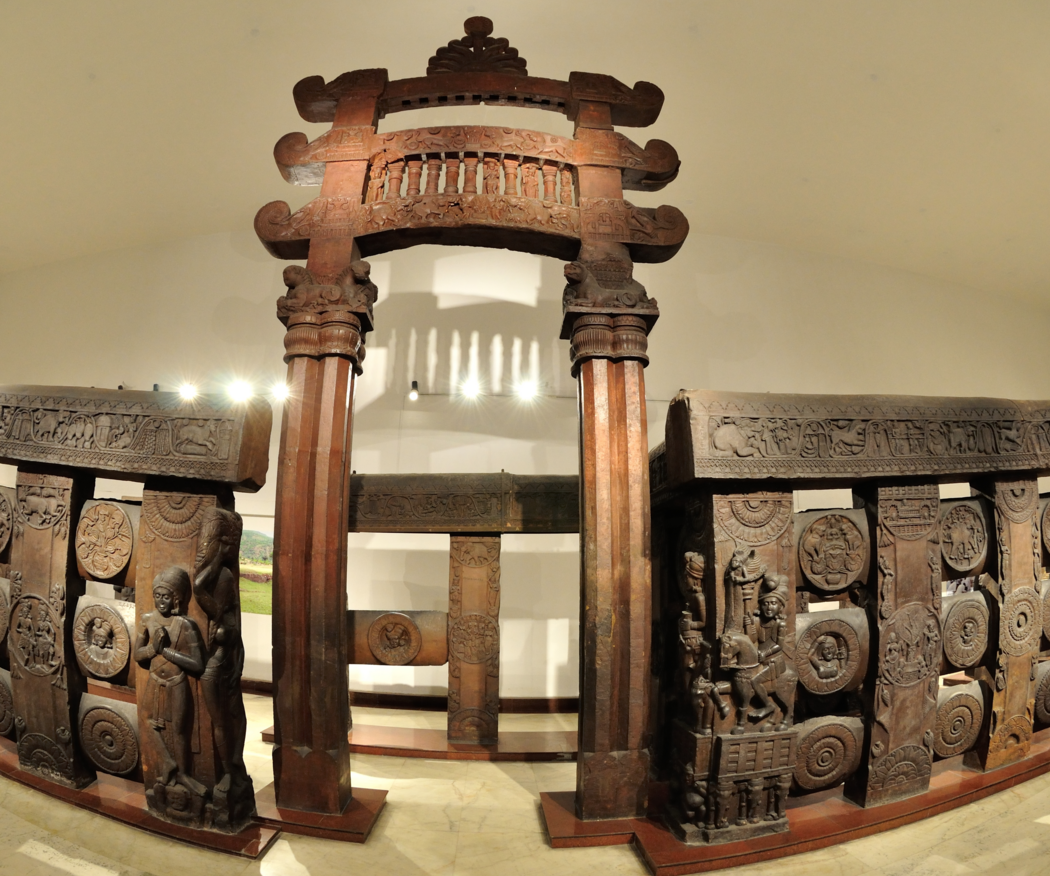
As evident, the Vedika and Torana have beautiful carvings. They are 5 elements –
1. Visual narratives about the life of Buddha
Buddha is represented in his iconic form – feet, bodhi tree, dharmachakra, empty seat and not the human form (symbolizing the Theravadin/ Hinayana Buddhism).
2. Jataka Kathas
Jatakas Stories like the Kaka Jataka(Monoscenic), Ruru Jataka
3. Yakshas and Yakshis
These gods of local cults start assimilating into Buddhism. It is believed that Yakshis were made through the contributions of women.
4. Medallions
There are also medallions like the one shown below. They represent the sun god, various bodhisattvas, etc.
Sanchi : Themes Represented
Sanchi Complex has 3 stupas. Follow the Map below.
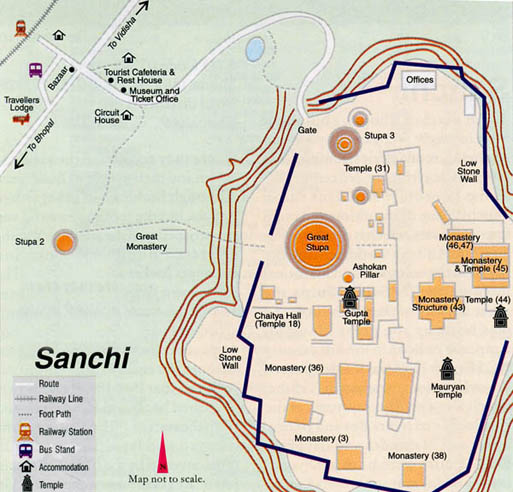
Stupa No. 1 is the largest and is called the Great Stupa. It has 4 gates with Toranas. In the pic, you see the Northern Gate.
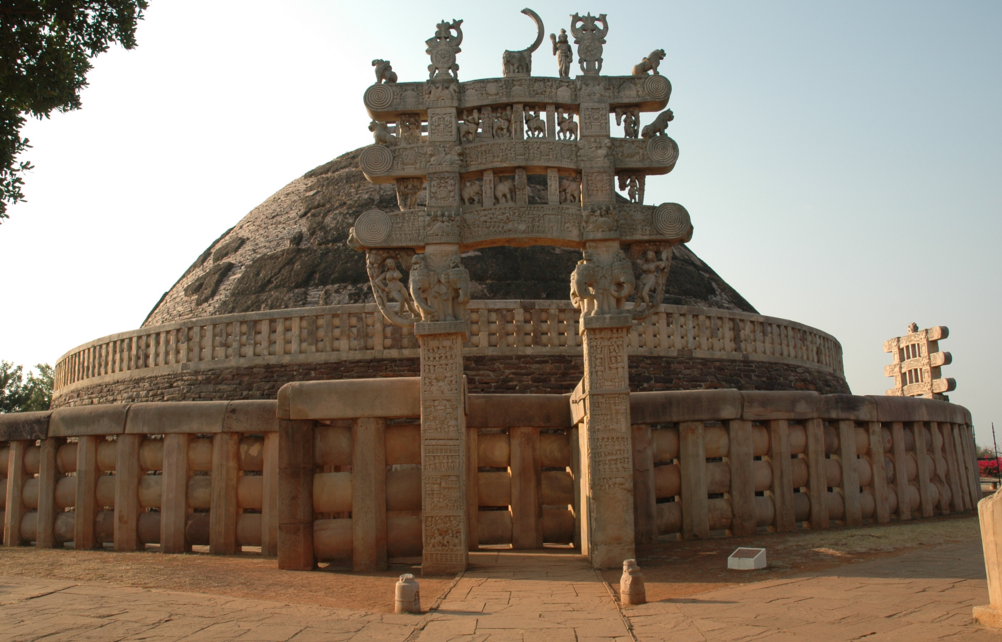
There are extensive carvings on the Torana. The themes are similar to those of Bharut.
Stupa 2 – This is the earliest stupa. Same time as Bharut but simpler.
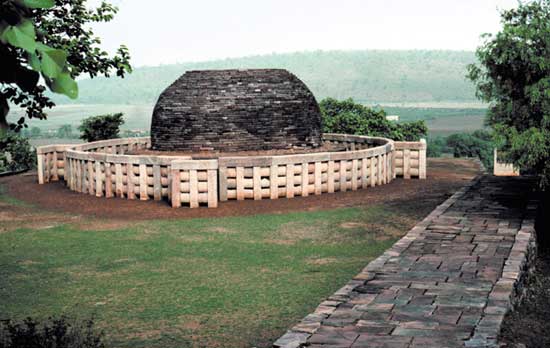
Stupa 3 –Has only 1 Torana.
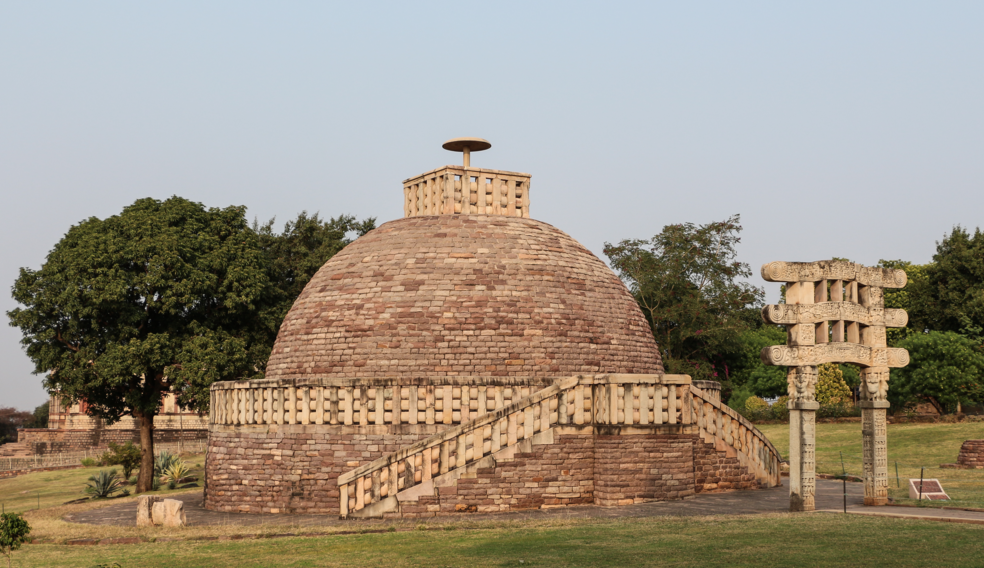
2. Pillars
1. Heliodorus Pillar
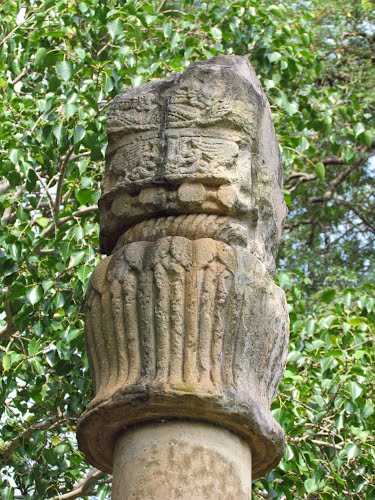
- Stone column erected by Heliodorus, Greek ambassador to the court of the Shunga king Bhagabhadra, around 150BC
- In honor of Vasudeva.
V. Independent Art
A. Sunga Art
-Standing sculptures of Yakshas and Yakshis, discovered from Gwalior and Mathura
-Dwarfish Yaksha from the Pithalkhora caves in Central India
B. The Gandhara School and the Mathura School of Art
This period saw the emergence to two very important schools of art – one in Gandhara, North West Frontier Province and the other in Mathura.
The Gandhara Art received patronage from various dynasties – Indo-Greek, Indo Scythian and Kushan Kings. It was during Kanishka’s reign that both these centers flourished.
| Gandhara | Mathura |
| Strong Greek influence and was based on Greco-Roman norms encapsulating foreign techniques and an alien spirit. It is also known as Graeco-Buddhist School of art. Assimilating various traits of Acamenian, Parthian and Bactrian traditions into the local tradition is a hallmark of the Gandhara style. | No foreign Influence, however, later it cross fertilized with the Gandhara School. Its development took place indigenously.Initially inspired by Yaksha Images |
| Blue-grey Mica / Grey Sandstone. | Spotted Red Sandstone |
| Rendering of drapery with sharp flowing folds similar to those shown in Roman togas.
Finer details and realistic images. Buddha carved out in various Mudras. Wavy curled hair. |
Early period: Light volume having fleshy body.
Later Period: Flashiness reduced. Not much attention to detailed sculpting. |
| Halo not decorated. Images are very expressive. | The halo around the head of Buddha was profusely decorated. Images less expressive. |
| Mainly Buddhism | All religions – Hinduism, Buddhism, Jainism |
Gandhara School : Themes represented
Buddha is depicted standing frontally with one leg bent.
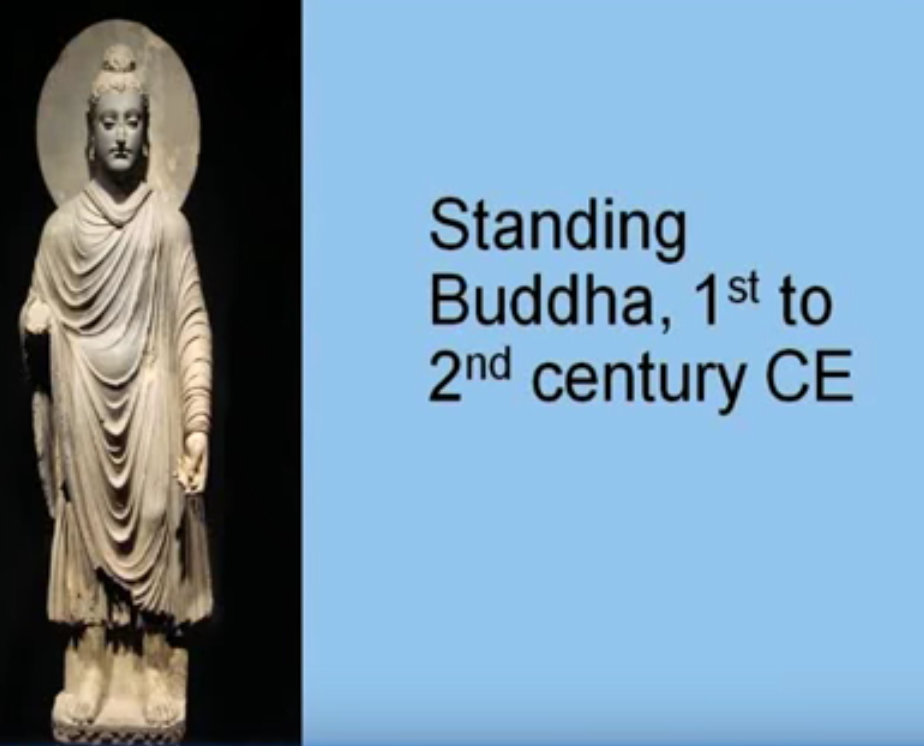
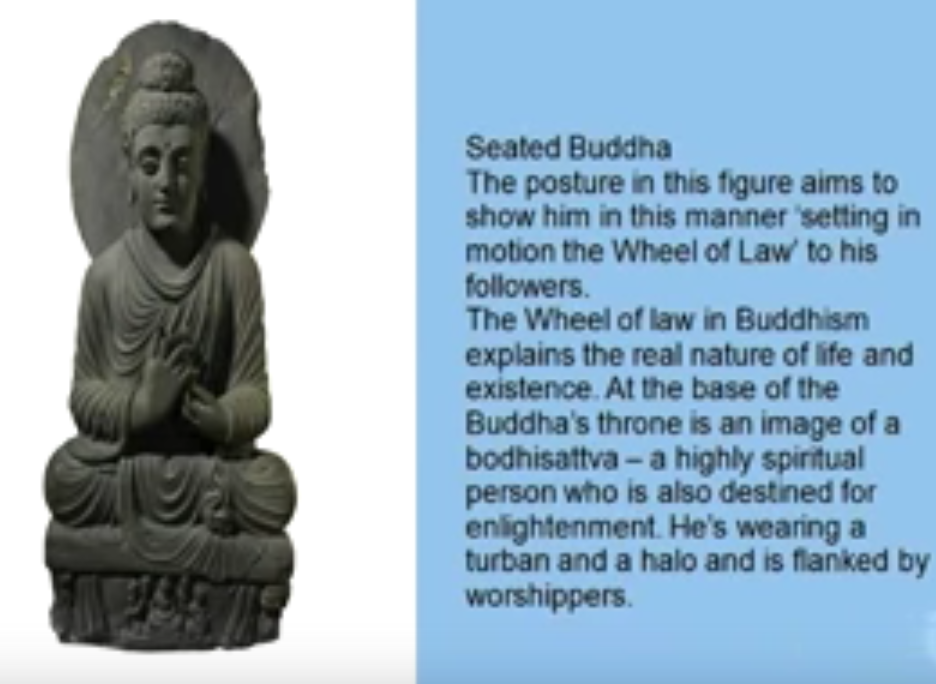
Greek Deities
Zeus Apollo, Athena indicating the Greeks wanted to preserve their culture.
Portraits of Kings
Other Sites
Mathura School – Themes represented
The Buddhist religion greatly flourished under the patronage of Kushan emperors, and several images of the Buddha and Bodhisattavas were produced after the earlier Yaksha types.
The first purely Indian Style art and sculptures were produced here. Mathura Art is famous for its iconographic traits – identification of particular deities based on the postures, attributes, vehicles.
Common Facial Features – Oval/ Roundish faces, open eyes, thick lips and sharp nose.
Fleshy full-body figures in a number of postures. Female figures are voluptuous, heavy round breasts, narrow waist. Male figures are shown with a slight V shape.
i. Buddhism
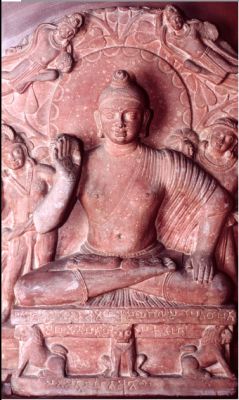
Buddha seen in Abhaymudra with one hand raised.
ii. Jainism
Mathura also becomes an important center of Jainism. A new kind of worshipping develops in this era – that of the Ayagapattas. The Jains produced votive tablets called ayagapattas that contain auspicious marks of worship such as fish couple or matsya yugala, the swatiska, etc.
Jain Ayagapattas with a Tirthankara at the middle.
iii. Shaivism
Various Shaiva images have been found from the region though their numbers are limited.
- Chaturmukhalinga.
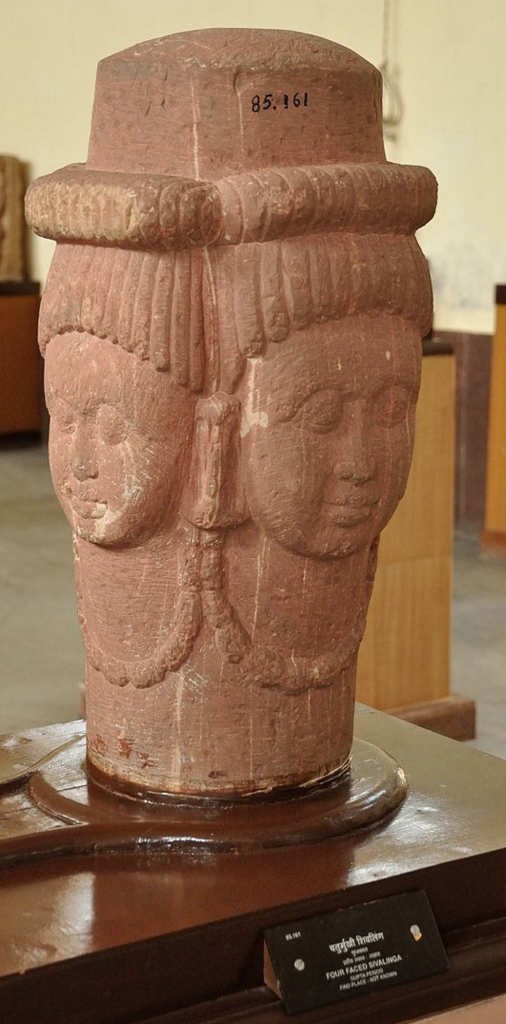
- Karttikeya-Skanda
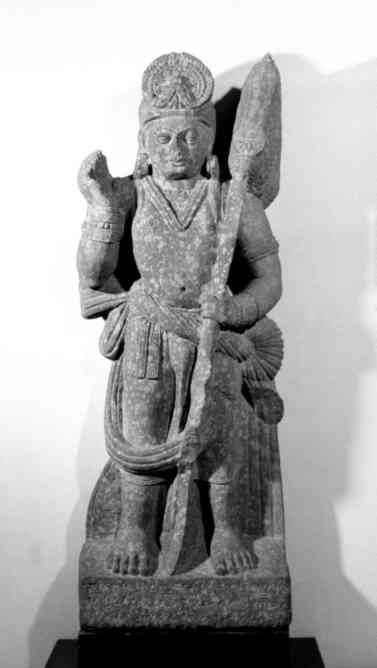
iv. Vaishnavism
- Balarama is shown with a snake canopy . Sometimes he carries a lion-staff plough.

v. Local Cults
Naga Cult is very prominent. A lot of Naga Temples have been found in/around this area.
vi. Statue of Kanishka
Last but not the least, we have the statue of Kanishka.
SOUTH INDIA
I. Political Background
In the south, the Sangam Period starts (circa 300BC – 300AD). We see the emergence for 3 main kingdoms
1. Cholas – Kaveri Delta
2. Cheras – Kaveri Karoor
3. Pandya – Vagai, Madhurai
In the Deccan, the Satvahanas declare themselves as independent after the fall of the Mauryan Empire and emerge as a powerful force. Their kingdom is centered around Aurangabad.
Their 3rd king, Satakarni I seems to have performed two Ashvamedhayajna. His achievements are described in detail in the Nanaghat Inscription. Referred to as lord of Dakshinapatha.
The strongest Satvahana ruler – Gautamiputra Satakarni carried out expeditions against the Saka rulers and drove them out of Maharashtra. His achievements are recorded in Nasik inscription. By 225 AD, the Satvahanas are replaced by Ikshwaku (refer map).
II. Literature
A. Sangam Literature
South sees the emergence of Tamil Language. For the first time we come to know of life in South India using literature. Sangam means assembly of scholars. Each Sangam consisted of a number of distinguished poets and erudite scholars who selected the best ones from amongst the works submitted to them. Many female authors seem to have contributed.
The Sangam classics, consisting of 18 works (8 anthologies of lyrics and 10 long poems), are well known for their directness of expression. The eight anthologies called the Ettuttogai are considered to be the earliest work belonging to the BC 300. The 10 poems called Pattupattu. They are divided in to
1) Aham deals purely with the subjective emotions of the lover.
2) Puram deals with objective emotions, mainly the valour and glory of kings, good and evil.
Some important works Sangam works are as follows –
| Name | Author | Notes |
| Thirukkural | Thiruvalluvar | Serves as a manual of precepts to guide one to noble living |
| Agattiyam | Agathiyar | The first known book on Tamil grammar, believed to be lost beyond redemption. |
| Tolkāppiyam | Tolkappiyar | Work on the grammar of the Tamil language and the earliest extant work of Tamil Literature and Linguistics. It talks of Thinai(explained below) |
Thinai : Another fascinating aspect of Sangam literature is its reference to 5 landscapes(eco-zones) and people associated with them known as Thinai.
| Ecozone as mentioned in Sangam Literature | Refers to | Associated human settlement |
| Marudam | Agricultural lands, Plains | Peasants, farmers |
| Mullai | Forest | Pastoral people |
| Palai | Desert Lands | Bandits, Travellers |
| Kurunji | Mountains/Hilly Areas | Hill tribes |
| Neydhal | Coastal Areas | Fishermen |
B. Tamil Epics outside the Sangam Literature
We have 5 great epics.
| No | Name | Author | Notes |
| 1 | Silappatikāram | Ilango Adigal | Love story between Kovalan who prefers the courtesan Madhavi of Kaveripattinam over his wife Kannagi. |
| 2 | Manimekalai | Cattan | Story of the daughter, Manimekalai, born out of love of Kovalan and Madhavi. There is also an elaborate exposition of the doctrines of Buddhism. |
| 3 | Cīvaka Cintāmaṇi | Adopted from Sanskrit Mahapurana, is predominantly sensuous, though Jain philosophy is brought to practical aspects of life | |
| 4 | Valayapathi | ||
| 5 | Kundalakēci |
III. Religion
We see no specific adherence to religion. The Sangam texts were secular in nature(one main reason how they differed from the Vedas)
IV. Architecture
A. Stupas
1. The Amaravati Stupa
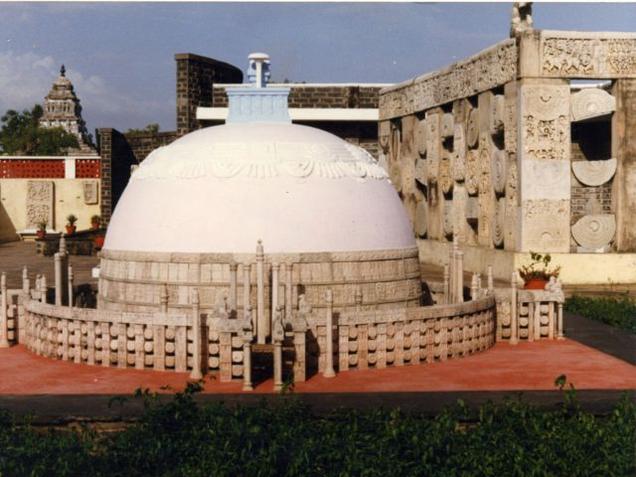
Covered with locally available white limestone.
5 pillars at each gateway. These 5 pillars represent the 5 milestones of the life of Buddha (discussed earlier)
Use this tool to explore further – http://www.ancientindia.co.uk/buddha/explore/intro.html.
2. Nagarjunakonda Stupa
Built by the successor of Satvahanas, the Ikshwakus. They continuted the great art traditions of Satvahanas.
B. Rock-cut caves
1. Karle caves & Bhaja caves
Both caves belong to Hinayana Buddhism.
Karla Cave is the largest Hinayana Buddhist Chaitya in India built during Satavahana’s rule. Karla is the best example of rock-cut architecture, which is believed to carve out from a living rock. Some of its 2000 year-old wooden beams are still alive.
Bhaja caves are also mainly Viharas and Chaityas.
- Noteworthy are the Dampati and the Mithuna figures as also the pairs riding the magnificent elephant crowning the pillars forming imposing colonnades.
- The figures are more than life size and are represented with powerful and muscular physique.
2. Ajanta caves
The earliest group of caves consists of caves 9, 10, 12, 13 and 15A. They were made during the period 100 BCE to 100 CE, probably under the patronage of the Satavahanas who ruled the region.
Check out our Case Study on Ajanta and Ellora to explore more.
V. Independent Art
A. The Amaravati School of Art
- Sculptural form in this area is characterised by intense emotions.
- Figures are slender, have a lot of movement, bodies are shown with three bents (i.e. tribhanga), and the sculptural composition is more complex than at Sanchi.
- White Marble was used in this art and the themes were Buddha’s life and Jatakas tales. The curly hairs of Buddha is a feature that is influenced by the Greeks.
- In this school, the Kings, Princes, Palaces etc. have got prominence.
A relief medallion from Amravati belonging to the 2 century A.D. is a masterly representation of a scene showing the subjugation or taming of Nalagiri, a mad elephant let loose on the Buddha.
Carving on outer wall of Amaravati Stupa
A famous carving depicts the adoration of the feet of the Buddha by four women and belongs to the 2nd century A.D. from Amravati.
Three-dimensional space in the relief sculpture is devised by using pronounced volume, angular bodies and complex overlapping.
References and Image credits:
http://www.madhyapradeshtourism.gov.in/avimage/MapSanchi.jpg
https://upload.wikimedia.org/wikipedia/commons/f/f3/Sanchi_Stupa.jpg
https://upload.wikimedia.org/wikipedia/commons/c/c3/Stupa_3,_Sanchi_01.jpg
https://upload.wikimedia.org/wikipedia/commons/b/be/Heliodorus_pillar.jpg
http://mw2.google.com/mw-panoramio/photos/medium/79445820.jpg
http://www.thehindu.com/multimedia/dynamic/02545/amaravathi_2545762f.jpg
http://media.web.britannica.com/eb-media/37/74737-004-85754D33.jpg
https://www.pinterest.com/pin/498351514987614297/
http://image.slidesharecdn.com/mauryan-gandhar-gupta-110424184708-phpapp01/95/mauryan-gandhargupta-23-728.jpg?cb=1303672249
http://www.britishmuseum.org/research/collection_online/collection_object_details.aspx?objectId=251183&partId=1





